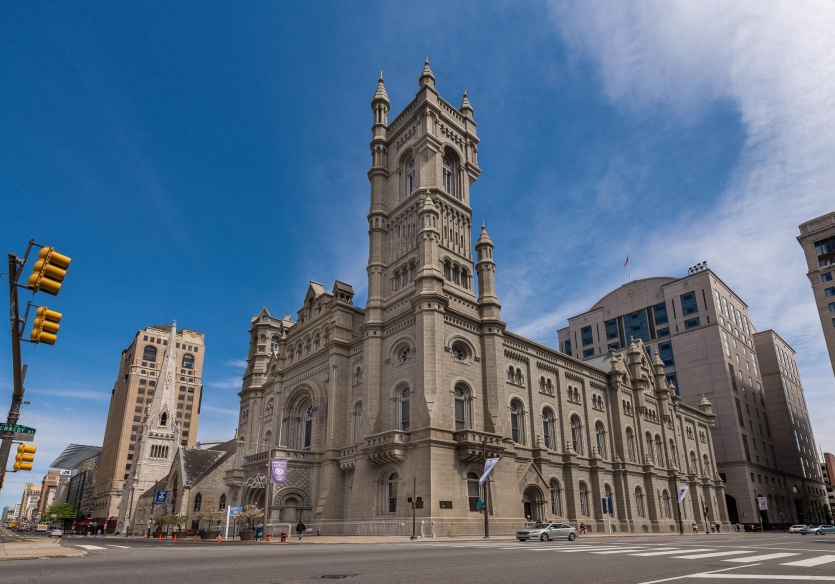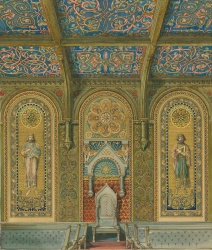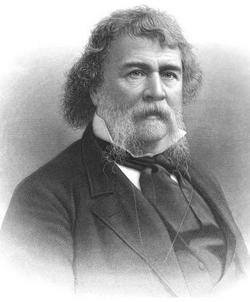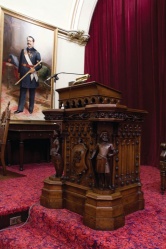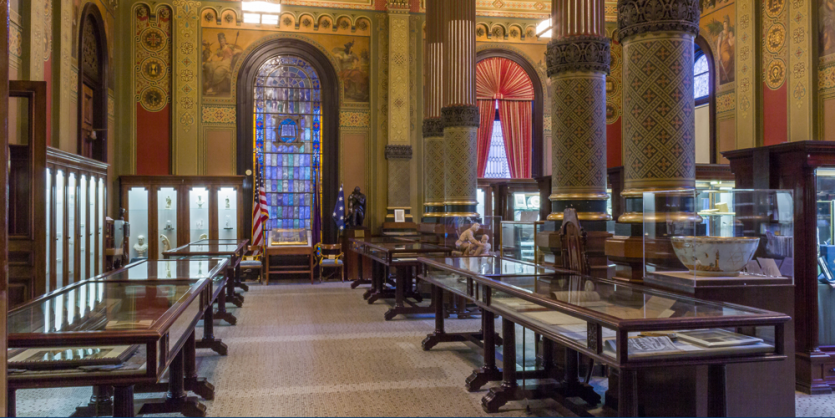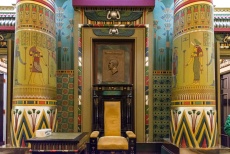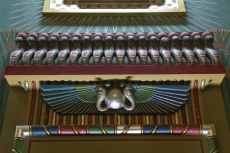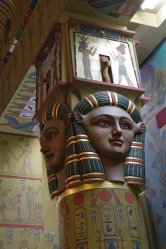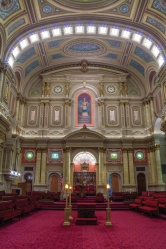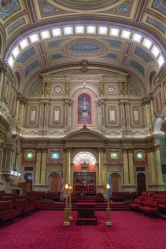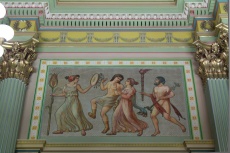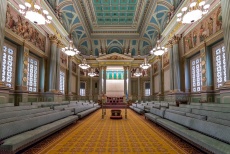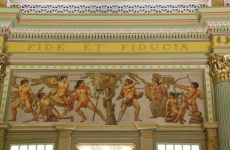En: The Masonic Temple in Philadelphia: Unterschied zwischen den Versionen
K (Formatiert) |
|||
| Zeile 1: | Zeile 1: | ||
[[Datei:12605313 828792433896498 8411652567577579732 o.jpg|thumb|835px|center]] | [[Datei:12605313 828792433896498 8411652567577579732 o.jpg|thumb|835px|center]] | ||
== The Masonic Temple in Philadelphia == | == The Masonic Temple in Philadelphia == | ||
| Zeile 113: | Zeile 110: | ||
Ionic Hall is unusual in that features full-length wall panel portraits of Right Worshipful Past Grand Masters: Joseph Eichbaum, Peter Fritz, Robert Clark, Conrad B. Day, Peter Williamson, John Thomson, William Barger, George E. Wagner, Michael Arnold, Henry V. Williams, Richard Vaux, Robert A. Lamberton, and Clifford P. McCalla. (Source: The Masonic Temple in Philadelphia, Grand Lodge F. & A.M. of PA, 2013) | Ionic Hall is unusual in that features full-length wall panel portraits of Right Worshipful Past Grand Masters: Joseph Eichbaum, Peter Fritz, Robert Clark, Conrad B. Day, Peter Williamson, John Thomson, William Barger, George E. Wagner, Michael Arnold, Henry V. Williams, Richard Vaux, Robert A. Lamberton, and Clifford P. McCalla. (Source: The Masonic Temple in Philadelphia, Grand Lodge F. & A.M. of PA, 2013) | ||
== Videos == | |||
<videoflash>SaSBIgJhDCU|800|400</videoflash> | |||
{{SORTIERUNG:Philadelphia}} | {{SORTIERUNG:Philadelphia}} | ||
[[Kategorie:English|Masonic Temple in Philadelphia]] | [[Kategorie:English|Masonic Temple in Philadelphia]] | ||
Version vom 18. März 2016, 09:10 Uhr
The Masonic Temple in Philadelphia
The Grand Lodge of Free and Accepted Masons of Pennsylvania is one of the oldest and largest Grand Lodges in the United States.
Founded in 1908, the Museum, housed inside of the Masonic Temple, was dedicated by Brother John Wanamaker, a prominent Philadelphia merchant who served as the first Chairman of the Library Committee. The Museum’s collection consists of more than 30,000 items. Some of these include Brother George Washington’s Masonic Apron, embroidered by Madame Lafayette, which was presented to the Grand Lodge of Pennsylvania in 1829 by the Washington Benevolent Society; two letters in Washington’s own hand addressed to his Masonic brethren; Brother Benjamin Franklin’s Masonic Sash, worn in 1782, when he was Venerable (Worshipful Master) of the Loge des Neuf Soeurs (Lodge of the Nine Sisters or Muses) in Paris, and when he Guided Brother Voltaire.
Courtesy of Grand Lodge of Free and Accepted Masons of Pennsylvania

When the Masonic Temple was built, it was constructed with Masonic principles in mind. The stones were cut, squared, marked and numbered at the quarries and brought to the Temple ready for use!
This photo dates from the 1880's. It shows the recently-completed Masonic Temple with Arch Street United Methodist Church at left and the construction site of City Hall on the right. Photograph by James Cremer (The Library Company of Philadelphia.) (Source: The Masonic Temple in Philadelphia, Grand Lodge F. & A.M. of PA, 2013)
George Herzog
George Herzog was arguably Philadelphia's leading decorative painter in the 1890's. He was already well known when the Art Association of the Masonic Temple first hired him to re-imagine the white walls of Egyptian Hall in 1888. The quality and quantity of the work he executed at the Masonic Temple over the next twenty years only increased his renown. (Source: The Masonic Temple in Philadelphia, Grand Lodge F. & A.M. of PA, 2013)
Renderings
Richard Vaux
Richard Vaux, former Mayor of Philadelphia, served as Grand Master of the Grand Lodge of Pennsylvania from 1868 to 1869. He was very involved with the construction of the Masonic Temple in Philadelphia, laying the cornerstone of the structure using the same gavel George Washington used during the placing of the cornerstone at the United States Capitol building.
Furniture
If the furniture and style look familiar, they should - much of it ended up being re-used in Gothic Hall in the current building.
Library and Museum
Your Masonic Library and Museum
That’s right – your Masonic Library and Museum! There’s more to a library and museum than housing, cataloguing and lending materials!
Did you know that…?
You can search the catalogue? You can either click here to go the online lending system or you can navigate there by clicking “Contact & Links”, then “Library” and scrolling down to the bar saying, “Click here to access our online catalogue and lending service.” It’s easy for Pennsylvania Masons to borrow books! Here’s how: When you find the title you want to borrow, double click on the record. The bibliographic information comes up and you will see “Save to bookbag.” Click on that. Towards the top of the resulting page, there are tabs. Click on “My Bookbag”. That will bring you to the page that has your title. Click on “Submit Request” and fill out the form. At the top right of the same screen, you will see “Send Request”. Click there and your request will go to the librarian. We search the records for deceased members and answer research questions for you, colleagues near and far, the Grand Lodge officers and staff, as well as the general public.
Send queries to GIR@pagrandlodge.org.
We write reviews of new books and articles to showcase museum items for The Pennsylvania Freemason.
We mount exhibits in the Masonic Temple and lend items to others’ exhibitions. We are active members of professional organizations.
We are proud to offer our services and expertise to Pennsylvania Masons – stop by sometime and say hello!
The Masonic Library and Museum is part of the Masonic Temple in Philadelphia, located at 1 North Broad Street, Philadelphia, PA, directly across from City Hall. The Masonic Library and Museum is open to everyone Tuesday through Friday 9 am to 5 pm; Saturday 9 am to 1 pm. Closed Sunday and Monday.
Egyptian Hall
Egyptian Hall is one of the most intricately detailed rooms in the building. Here, we see the Uraei, otherwise known as sacred asps or rearing cobras, above the winged sun disk. Egyptian Hall was also the first room to have electricity, better enabling the members to see the fine detail. (Source: The Masonic Temple in Philadelphia, Grand Lodge F. & A.M. of PA, 2013)
Each of the columns in Egyptian Hall is modeled after an original column in Egypt. The sections of the columns have borders or reeds and rushes, a fluted frieze, the flying sun-disk, the Uraeus and other symbolic motifs. Lotus flowers twine around the base of the columns, reed decorations are on the cornice and pyramidal designs complete the panels. (Source: Masonic Temple in Philadelphia, 1954, hard bound edition.)
Renaissance Hall
In 1906, Murray Gibson renovated Renaissance Hall. Gibson's artisans repainted the room, using red - the symbolic color of Royal Arch Masonry - as much as possible and introducing gold interlaced stenciling to the borders of the ceiling panels. In place of the gas lights, he added electric fixtures to the ceiling beams and laylight. In addition, Gibson convinced the Committee on the Temple to light the walls indirectly using Moore vacuum-tube lamps (a predecessor technology to neon lamps) that provided even white illumination. (Source: The Masonic Temple in Philadelphia, Grand Lodge F. & A.M. of PA, 2013)
Corinthian Hall
Corinthian Hall is the largest ceremonial room in the Temple, designed specifically for such occasions and able to seat 400 brothers.
Depicted here is one of the many murals that decorate the walls of Corinthian Hall. This particular panel depicts a nuptial scene. A girl with a lily, the symbol of purity, in one hand and a tympanon in the other, is leading the young couple into their new home. A satyr, carrying a candelabrum and torch, ends the procession. (Source: Masonic Temple in Philadelphia, 1954, hard bound edition.)
This mural is on the West Wall of Corinthian Hall. It depicts Jason and Hercules, with the help of Medea, attacking the dragon. In the center of the scene is a tree, dividing it into two equal parts. Upon the branches is suspended the Golden Fleece. Above the trunk is coiled the dragon which guards it. (Source: Masonic Temple in Philadelphia, 1954, hard bound edition.)
Oriental Hall
Ionic Hall
Ionic Hall is unusual in that features full-length wall panel portraits of Right Worshipful Past Grand Masters: Joseph Eichbaum, Peter Fritz, Robert Clark, Conrad B. Day, Peter Williamson, John Thomson, William Barger, George E. Wagner, Michael Arnold, Henry V. Williams, Richard Vaux, Robert A. Lamberton, and Clifford P. McCalla. (Source: The Masonic Temple in Philadelphia, Grand Lodge F. & A.M. of PA, 2013)
Videos
<videoflash>SaSBIgJhDCU|800|400</videoflash>

